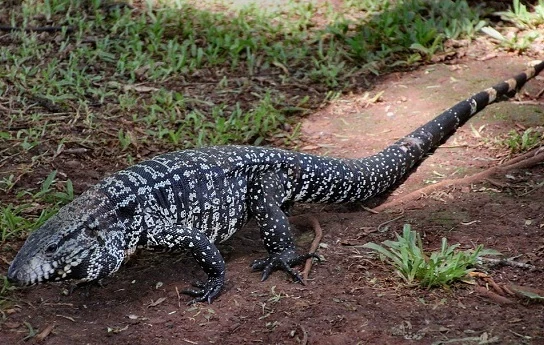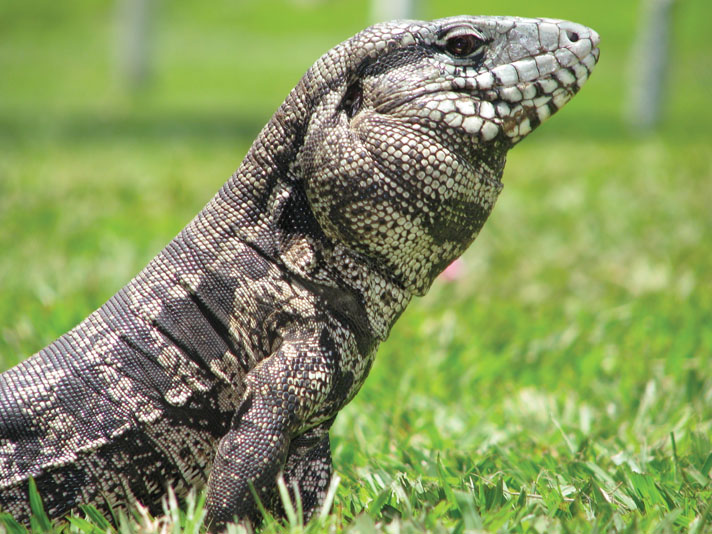Argentine Monitor Lizards, particularly the Argentine Black and White Tegu, are captivating reptiles that are gaining popularity in the exotic pet world. Known for their striking appearance, intelligence, and relatively docile nature, these lizards are an excellent choice for experienced reptile enthusiasts. However, their size and specific care requirements make them a commitment that should not be taken lightly. This guide will walk you through everything you need to know about caring for an Argentine Monitor Lizard, from habitat setup to diet and more.
What Is an Argentine Monitor Lizard?
Origin and Habitat in the Wild
Argentine Monitor Lizards, specifically the Argentine Black and White Tegu, are native to South America, primarily Argentina, Brazil, and Uruguay. In the wild, they thrive in a variety of environments, including grasslands, tropical rainforests, and semi-arid regions. These highly adaptable reptiles are known for their ability to burrow and seek shelter under rocks and logs, allowing them to regulate their body temperature.

Characteristics of the Argentine Monitor Lizard
The Argentine Black and White Tegu is one of the largest species of tegu lizards, growing up to 4.5 feet in length, with males generally being larger than females. They have a striking black and white coloration that gives them their name, and their robust body and strong limbs make them powerful diggers. With a lifespan of 15 to 20 years in captivity, these lizards are a long-term commitment. Their intelligence, coupled with their calm demeanor when properly cared for, makes them highly engaging pets.
Setting Up the Perfect Habitat for Your Argentine Monitor Lizard
Choosing the Right Enclosure
Argentine Monitor Lizards need spacious enclosures due to their size and active nature. A minimum enclosure size for an adult should be around 6 feet long, 3 feet wide, and 2 feet tall. Glass terrariums or custom-built enclosures work best, ensuring that your lizard has enough room to move around and explore. Ventilation is key, so make sure the enclosure is well-aerated while maintaining the proper temperature and humidity levels.

Temperature and Humidity Requirements
As ectothermic animals, Argentine Monitor Lizards rely on external heat sources to regulate their body temperature. The enclosure should have a temperature gradient, with a basking spot that reaches between 95°F and 100°F, and cooler areas ranging from 75°F to 85°F. Humidity levels should be kept between 60% and 80%, which can be maintained by misting the enclosure daily or using a humidity control system.
Substrates and Furnishings
Choosing the right substrate is important for replicating the lizard’s natural environment and for burrowing. Coconut fiber, cypress mulch, and soil mixtures are excellent choices as they help retain humidity. Include large hides, branches, and rocks in the enclosure to provide the lizard with enrichment and opportunities for climbing and hiding. A large water dish should also be available for soaking, as Argentine Monitor Lizards enjoy bathing.
Diet and Feeding Habits of the Argentine Monitor Lizard
What to Feed Your Argentine Monitor Lizard
Argentine Black and White Tegus are omnivores, meaning they eat a wide variety of foods. Their diet should include a mixture of animal proteins and plant matter. Insects like crickets, roaches, and mealworms are essential for young lizards, while adults can be fed larger prey like mice, small rats, and even eggs. Additionally, fruits such as berries, mango, and papaya can be offered in moderation. Providing a varied diet ensures that they receive all the necessary nutrients.
Frequency and Portion Sizes
Young Argentine Tegus need to be fed daily, while adult lizards can be fed every 2-3 days. The amount of food should be based on the size and activity level of your lizard. Overfeeding can lead to obesity, so it’s important to monitor portion sizes carefully. For adult lizards, a portion of food should be roughly the size of their head.

Handling and Taming Your Argentine Monitor Lizard
How to Properly Handle Your Lizard
Handling your Argentine Monitor Lizard regularly helps them become more comfortable with human interaction. When handling your lizard, approach them slowly and gently lift them from underneath, supporting their body and tail. Avoid grabbing them from above, as this can cause stress. With time, they will become more accustomed to handling, though each lizard will have its own personality and tolerance levels.
Avoiding Stress in Your Lizard
Signs of stress in Argentine Monitor Lizards include excessive hiding, a refusal to eat, or aggressive behaviors like hissing or tail whipping. To avoid stressing your lizard, handle them calmly, provide a well-maintained habitat, and ensure they have plenty of hiding spaces. Keep environmental disturbances, such as loud noises or too much activity around their enclosure, to a minimum.
Common Health Issues and How to Prevent Them
Recognizing Signs of Illness
Argentine Monitor Lizards are prone to certain health issues, including respiratory infections, metabolic bone disease (MBD), and parasites. Symptoms of respiratory infections include wheezing, lethargy, and discharge from the nose or mouth. MBD is caused by a lack of calcium and UVB lighting and results in weakened bones and deformities. Regular monitoring and vet visits can help prevent these issues.
Regular Veterinary Care for Your Lizard
Exotic pets like Argentine Monitor Lizards require specialized veterinary care. Regular check-ups with a vet experienced in reptiles are essential to maintain your lizard’s health. It’s important to establish a relationship with a vet early on, as catching potential issues early can prevent them from becoming more serious.
Conclusion
Argentine Monitor Lizards, particularly the Argentine Black and White Tegu, are fascinating, intelligent, and rewarding pets for those who are prepared to meet their care requirements. Their unique appearance and engaging behaviors make them a standout among reptile pets. However, their large size and long lifespan mean that potential owners should be ready for a long-term commitment. With proper care, these lizards can thrive in captivity and become loyal companions.
FAQs:
- What is the ideal temperature for an Argentine Monitor Lizard?
Argentine Monitor Lizards need a basking spot that reaches between 95°F and 100°F, with cooler areas ranging from 75°F to 85°F. - How often should I feed my Argentine Black and White Tegu?
Young Tegus should be fed daily, while adults can be fed every 2-3 days with appropriate portion sizes based on their size and activity level. - Do Argentine Monitor Lizards get along with other pets?
It’s generally not recommended to house Argentine Monitor Lizards with other pets, as they can be territorial and may see smaller animals as prey. - How big can an Argentine Monitor Lizard get?
Argentine Black and White Tegus can grow up to 4.5 feet in length, with males generally being larger than females.
